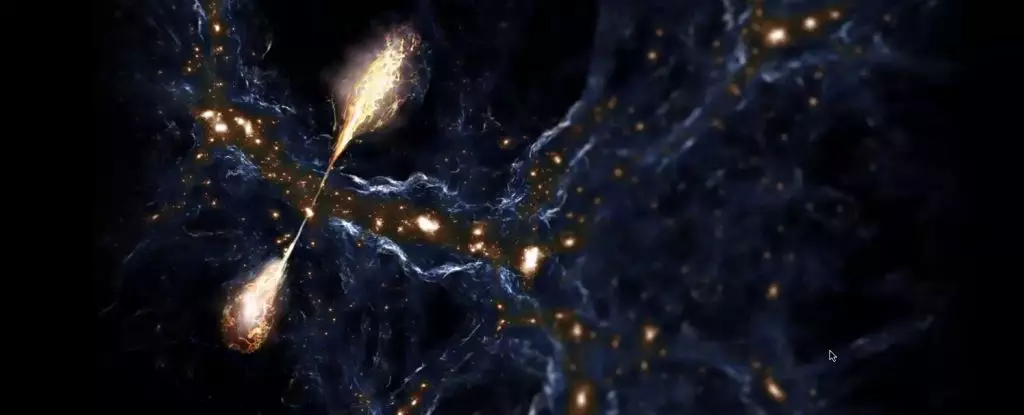Astrophysical wonders often remind us how much we have yet to learn about the universe, and the discovery of Porphyrion—a colossal structure formed by supermassive black hole jets—exemplifies this marvel. With its dimensions exceeding 23 million light-years, Porphyrion is the largest galactic structure identified to date, raising profound questions about the dynamics of black holes and their influence on cosmic architecture.
Porphyrion, named after a giant from Greek mythology, stretches across an astonishing 7 megaparsecs. This structure not only signifies an immense feat of cosmic engineering but also serves as a testament to exploration endeavors in astrometry. The significance of its find lies within the intricate tapestry of the cosmic web—the vast interconnected network of galaxies, dark matter filaments, and voids.
Martijn Oei, an astronomer from Leiden University and Caltech, elucidates the dramatic implications of this discovery. He emphasizes the interconnectedness of cosmic elements, suggesting that even minute entities, like a black hole the size of an amoeba, can catalyze monumental structures. To frame it in perspective, if we were to scale down black hole jets to earthly dimensions, they would appear not only autonomous but also remarkably powerful, akin to an amoeba propelling a fountain across a terrain the size of Earth.
Astrophysical jets emerging from black holes have long been a subject of intrigue, yet the mechanisms underlying their formation remain puzzling. Conventional understanding points to a black hole’s feeding process, wherein material from an accretion disk—a rotating disk of gas and dust spiraling towards the black hole—is diverted along magnetic field lines towards the poles, resulting in high-velocity jets of plasma.
However, Porphyrion isn’t an isolated case. Following the discovery of Alcyoneus, another galaxy with jets stretching an impressive 16 million light-years, the phenomenon seems less abnormal and more characteristic of the cosmic landscape. The frequent occurrence of such monumental jets prompts a critical reassessment of black hole activity and intergalactic feeding cycles.
The formation conditions necessary for such expansive jets raise doubts; for instance, the continuous feeding of the black hole must occur over immense time scales, potentially spanning close to a billion years. Such prolonged activity isn’t typical, thereby challenging existing paradigms of black hole evolution.
A fascinating aspect surrounding these astrophysical jets is their remarkable stability over vast distances. According to Oei, both theoretical and computational analyses indicate that jets are generally unstable and prone to disturbances that may lead to their disintegration. Thus, the survival of jets like those from Porphyrion prompts inquiries into the broader implications for cosmic structure formation.
The ability of these jets to maintain coherence over extensive spatial-scale transformations raises questions about the processes responsible for stabilizing them. Their length, serving as approximately two-thirds of the radius of the void they occupy, suggests significant implications for understanding the interplay between jets and the cosmic web.
Furthermore, the jets may contribute to the remarkably high temperatures observed in intergalactic voids, creating magnetic field structures that influence the behavior of dark matter. Such hypotheses pivot into complex realms of astrophysical interactions, hinting that the influence of black hole jets may extend far beyond their immediate vicinity.
As astronomers delve deeper into the complexity surrounding colossal black hole jets, the landscape of our understanding of galactic formations is poised for transformation. Oei speculates that giant jets may be more common in the universe than current observational limitations allow us to perceive. As detection methods evolve, likely aided by advancing telescope technologies, we may encounter many more supermassive black holes exhibiting similar jets.
The potential significance of discovering additional cases of giant jets in the future lies in their impact on cosmic evolution. Understanding how these extraordinary jets fit into the larger secular framework of the universe could yield critical insights into the processes that shaped early cosmic structures.
The study of Porphyrion and the jets related to it isn’t merely an academic exercise; it presents a window into the underlying principles that govern the universe. While incredible discoveries await, each revelation inspires new inquiries about the nature of black holes, their feeding mechanisms, and the grand organization of the cosmos. As scientists push through the boundaries of our current limitations, we stand on the cusp of unveiling cosmic truths, still very much akin to mysteries wrapped in the fabric of time and space.


Leave a Reply